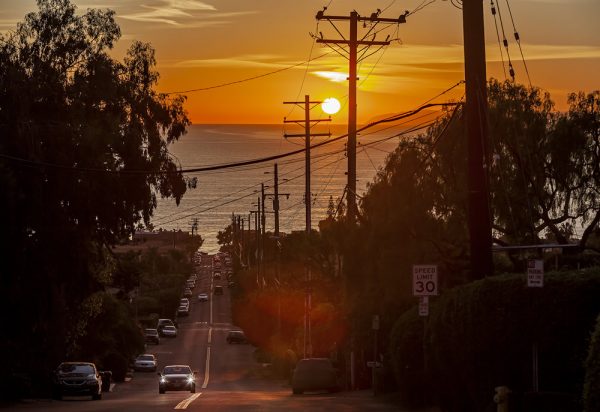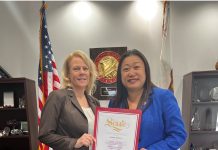
In recent weeks 500 local residents answered survey queries about their attitudes towards a possible ballot measure to fund the removal of utility poles from Laguna Canyon and other evacuation routes in order to reduce wildfire risk.
The survey results are due to be released next week and will inform the discussion by the City Council at its meeting Tuesday, Feb. 6.
Coincidently, three catastrophic events in the state and a change in federal tax laws could both influence the outcome.
The survey comes in the wake of two recent massive wildfires in Sonoma and Ventura counties and a disastrous mudflow in Montecito. Downed power lines have sparked massive California wildfires in the past, including six in Laguna Beach in recent years, and utilities from San Diego to Northern California have made millions of dollars in payouts.
A power-line sparked blaze in Laguna Canyon on a peak summer weekend in 2015 that led to widespread gridlock ignited the current campaign to try to fend off future disasters. Legislative efforts and coaxing of utility officials to rid the city of above ground lines since then have so far failed.
Now, city officials contemplate undertaking the task on their own by turning to the ballot box in November. Hiring the advisory service TBWB Strategies of San Francisco to help sharpen its message by surveying attitudes served as a first step.
“We want to try to find out what people support,” said City Manager John Pietig. “We only get one shot at crafting something people are interested in.”
Survey questions attempted to discern resident support for imposing at least two possible tax methods to pay for an estimated $115 million project to remove strands of utility wiring from major access ways. Survey respondents were informed that debt repayment would take 30 years.
Survey takers were queried about their support for footing the bill by way of an added property tax, amounting to $40 per year for every $100,000 in property valuation.
One question seemed to test attitudes toward a tax on visitors, due to their demand on city services.
Other questions asked respondents to rank the importance of provisions that could be integrated into a ballot measure, such as citizen oversight, keeping all funds in Laguna Beach and minimizing dust and noise.
The survey also asked residents who support a bond measure to fund the burying of utility poles what argument they find persuasive: that newer cities are built with underground lines, the necessity of preparing for natural disasters, the town’s vulnerability in a high-fire zone, the conclusion of fire safety experts that eliminating poles reduces threats and that utility equipment caused six local fires in Laguna, where a ’93 fire consumed 440 homes and caused $838 million in damage.
“I am convinced that the risk of a catastrophic fire from utility lines and equipment is real with the Wine Country and Southern California fires being just the most recent examples,” said Council member Bob Whalen, who as mayor in 2015 stepped up the pressure to underground utilities. “In my view, spending to prevent a fire disaster is a far better course than waiting for disaster to strike.”
Council member Rob Zur Schmiede, who worked with Whalen on the citywide undergrounding proposal, said they explored various funding mechanisms, including how to foist costs on visitors. A sales tax increase would substantially be born by the town’s 6.3 million annual visitors.
“I don’t see any realistic alternatives beyond ballot measures. There is no magic pot of money out there to get this done,” said Whalen, a lawyer who specializes in public finance.
If voters reject issuing debt to fund undergrounding, city officials will have to figure out how to best use $2.5 million a year already identified for such a project, which would then take decades to complete, he said.
One unanticipated wrinkle in the city’s ballot measure calculations comes from newly enacted changes in federal tax law, which put a limit of $10,000 on the amount of state and local property taxes that individuals can deduct annually.
Voters might hesitate to support a ballot measure that adds a tax cost that no longer qualifies as a tax deduction.
“This is going to be a factor; at a minimum it will be a question mark,” Zur Schmiede said.
Whalen said he couldn’t guess the impact of the new federal tax law on the survey’s outcome. Property owners who don’t itemize would be indifferent, he said. About 29 percent of the nation’s taxpayers itemized deductions in 2016, an IRS spokesman said.
“Of course it is likely a higher percentage of property owners in Laguna itemize,” Whalen said.
In fact, 59 percent of 12,004 tax returns filed in 2010 from the 92651 zip code itemized for deductions, according to the most recent IRS records available.
“If residents are not convinced overhead utilities are a big enough risk that they are willing to tax themselves, that will be their decision,” Zur Schmiede said.





[…] results of the 685-resident survey to assess attitudes towards possible November ballot measures to fund such projects were presented […]